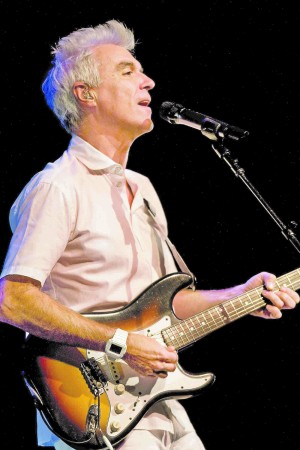Concert Review: David Byrne, Clowes Hall, Indianapolis
Songs from “Everything That Happens” opened and closed the concert: The effortless and lovely “Strange Overtones” established a mid-tempo pop vibe while “Everything That Happens” functioned as a sort of lullaby, a third encore to quiet an enthusiastic, near sell-out crowd. As the band (two drummers, a keyboardist, bassist and Byrne on guitar) led into “I Zimbra,” the dancers made their first appearance on stage, running straight for the backup singers to steal their mic stands and haul them to the front of the stage. Thus began a give and take between singers and dancers, with the singers chasing down their mics, joining dancers in group dance numbers, splitting off into couples and expressing mock surprise and an infectious joy at each new provocation and move. The dancers brought a sort of trickster energy to the proceedings throughout, spinning Byrne in a disorienting circle, for instance, just before he launched into a song, and depicting office workers struggling to rise from their chairs to dance on “Life Is Long.” They executed even synchronized ensemble numbers with what seemed an improvised casualness, each figure choreographed with an intelligence that sometimes engaged with the lyrical content of the song (flowing movements and clichéd fist rolls with elbows out on “Once In a Lifetime” to suggest the rolling of waves and passage of time), and at other times simply sought the most interesting move (robotic figures and other group dances on “Life During Wartime”). After the outstanding spiritual “One Fine Day” — a more literal example of the “electronic gospel” that Eno says he aimed for on their new album — Byrne explained that the chorus, “Everything can change, one fine day,” could refer to an upcoming election. It was one of few asides by Byrne; he opened the show by asking if there was anyone from FFA in town (alluding to those blue corduroy jackets just as Obama did in his stump speech Thursday), and later explained that the chorus of “Heaven” — “Heaven is a place where nothing ever happens” — is probably true: “Sitting around with harps on clouds doesn’t seem like much going on to me.” Byrne and his band faithfully recreated Talking Heads classics, sliding between different eras easily, from the minor-key electro-pop of “Air” and “Life During Wartime,” opening up to the more organic sound of “Take Me to the River” and “Burning Down the House,” breaking out acoustic guitars for “Heaven.” But the second percussionist also brought along bongos, and the band headed for the cosmopolitan territory that has motivated Byrne’s music ever since the first Talking Heads album integrated steel drum into the first track. The song from “Bush of Ghosts,” “Help Me Somebody” — with Byrne singing the vocal sample from the album (all vocals are samples on that album, and Byrne doesn’t sing) — struck a soulful Afrobeat groove as Byrne tried to channel the preacher on the sample.
|






 There may be some obvious reasons why David Byrne is such a compelling performer: his height, spiky grey hair, a sort of rigid grace (if such a thing is possible), vocals that sound much more relaxed since first recorded in the late ’70s (although he can still access that grimacing panic). But his show Saturday night at Clowes Hall didn’t rely only on his magnetism (though that was in full force) or on the strength of his hits with the Talking Heads (though he played them all before the night was through). Rather, he seamlessly integrated material from his collaborations with Brian Eno — including an arrangement of a sound collage from their “
There may be some obvious reasons why David Byrne is such a compelling performer: his height, spiky grey hair, a sort of rigid grace (if such a thing is possible), vocals that sound much more relaxed since first recorded in the late ’70s (although he can still access that grimacing panic). But his show Saturday night at Clowes Hall didn’t rely only on his magnetism (though that was in full force) or on the strength of his hits with the Talking Heads (though he played them all before the night was through). Rather, he seamlessly integrated material from his collaborations with Brian Eno — including an arrangement of a sound collage from their “